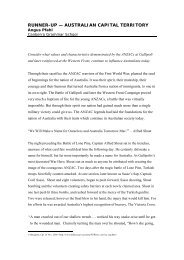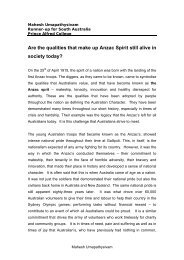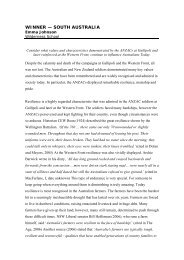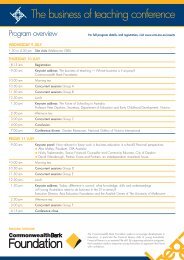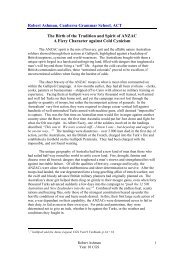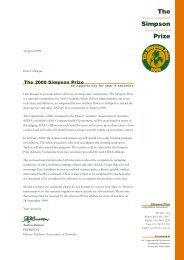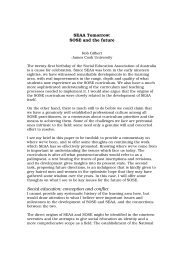Brady Inman - afssse
Brady Inman - afssse
Brady Inman - afssse
You also want an ePaper? Increase the reach of your titles
YUMPU automatically turns print PDFs into web optimized ePapers that Google loves.
2008 runner-up<br />
Western Australia<br />
<strong>Brady</strong> <strong>Inman</strong><br />
Scotch College
To what extent was Simpson<br />
a hero How have his heroic<br />
qualities been demonstrated by<br />
other Australians since 1915<br />
by <strong>Brady</strong> <strong>Inman</strong>, Scotch College<br />
Simpson: is his heroic status justified<br />
John Simpson-Kirkpatrick is an Australian legend; he is the most renowned hero of the<br />
ANZACs. His story has been taught to generations of Australians, but like all stories, it<br />
has changed over time. It is essential to look beyond the façade that has faithfully preserved<br />
the legend of Simpson and his donkey to conclude as to whether he was a true hero in the<br />
spirit of the ANZAC legend. It may be the case that the story of<br />
Simpson has been embellished by Australian folklore over the<br />
years. Furthermore, there have been numerous other Australians<br />
who have excelled in a vast range of areas who can rightfully<br />
claim the title of ‘hero’. A hero does not need to be someone who<br />
has been constructed by the media or propagated through other<br />
mediums. Many Australians have proven themselves on other<br />
‘battlefields’, such as the expansive Australian coastal waters as<br />
well as the harsh outback which is subject to periodic fires. As a<br />
nation, it is necessary to look beyond the famous heroes, and look<br />
at our everyday heroes like the volunteer surf lifesavers who have saved countless lives, or<br />
the firefighters who have saved people homes and livelihoods.<br />
John Simpson Kirkpatrick is known as an Australian hero; he is one of the best known<br />
soldiers to serve in the Australian imperial force, even though he was not an armed<br />
soldier or even Australian. Simpson was born in 1892, in South Shields, England. The<br />
son of a Scottish couple who had moved to England in 1886, Simpson left home in 1909<br />
beginning work as a stocker and steward on merchant ships. One year later, he jumped<br />
ship in Australia, and found work as a coal miner. He moved between ships, finding work<br />
wherever he could. Simpson was later a stretcher bearer for the ANZACs in Gallipoli during<br />
World War One. He landed at ANZAC cove on April 25 1915, and beginning on that first<br />
night he took a donkey and would carry the wounded from the front line to the beach for<br />
evacuation. 1 He worked under constant fire, for three and a half weeks until he was shot<br />
dead on one of his trips. Australians today see Simpson as one of the great ANZAC legends.<br />
Runner-up Western Australia, <strong>Brady</strong> <strong>Inman</strong>, Scotch College – Page 2 of 5
The commonly believed story of Simpson is that he arrived in Gallipoli and was the only one<br />
of his battalion to arrive on the beach unscathed, so instead of following orders he began<br />
to work as an independent unit. At Gallipoli Simpson employed the services of a donkey that<br />
had arrived on one of the ships to transport the wounded from the front line to the beach for<br />
evacuation 2 . However, it is without a doubt that this story has been glorified and embellished;<br />
numerous writers and historians such as C.E.W Bean have tailored this story to suit the legend<br />
of the first ever ANZACs who fought gallantly against all odds at Gallipoli in 1915.<br />
What Australians either ignore or choose not to believe is the story that is closer to the<br />
truth. In this version Simpson disbarred himself from his unit and instead found an easier<br />
task where he was his own boss. The task he chose was to use a donkey to transport slightly<br />
wounded soldiers from the front line to the beach employing the services of a donkey: this<br />
task was far easier. As Wilson notes:<br />
much has been said about the perils and dangers of his job, but his chosen task was much<br />
safer then his assigned duty of a stretcher bearer. Simpson was a stretcher bearer, not a<br />
donkey driver, and the only people he could carry on his donkey, were slightly wounded<br />
soldiers who were capable of walking down themselves. 3<br />
Any seriously wounded men would have been unable to ride on the donkey because they<br />
would not have been able to support themselves on the donkey correctly. If Simpson was a<br />
true hero he would have been doing the duties he was assigned, working with the stretcher<br />
bearer unit. The stretcher bearer unit that he worked with would have been short one man<br />
which would have made their work much harder. 4<br />
All the stories of Simpson talk of how brave he must have been, walking up and down<br />
Shrapnel and Monash gulley under constant enemy fire. These stories literally make out that<br />
Simpson must have been the only man doing this courageous task. However, this is not the<br />
truth. The two gullies were like busy highways; there would have been hundreds of men<br />
taking the routes at any given time, so in fact Simpson was no braver then any other man<br />
who was involved in the Gallipoli assault. The truth is that he was a British subject who<br />
was in Australia at the time when war started; he wanted to enlist because it was thought<br />
that his regiment would do training in England. Instead they went to Egypt and then headed<br />
straight to Gallipoli. Once at Gallipoli, he showed no more bravery or courage then any<br />
other ANZAC who fought to save ‘King and Country’ 5 .<br />
The Australian nation is a proud country, who has had many heroes over its short history.<br />
Since 1915, their have been prominent heroes in very generation. To be a hero is not<br />
an easy thing; one needs to be utterly selfless, determined, courageous and gallant 6 . The<br />
ANZACs are Australian heroes; their heroism was proved countless times by their efforts<br />
on the battlefield. It was proven by their courage, compassion, comradeship, endurance,<br />
selflessness, resourcefulness, independence and initiative. These were the qualities that made<br />
them heroes, but their larrikinism and humour made them not only an Australian legend,<br />
but world renowned. Subsequently, every ANZAC who served during the First World War<br />
deserves to be as widely celebrated as Simpson has been.<br />
Runner-up Western Australia, <strong>Brady</strong> <strong>Inman</strong>, Scotch College – Page 3 of 5
There are many heroes in the military and sporting world, but the true Australian heroes<br />
are often overlooked. To discover the real heroes of Australia one needs to look beyond<br />
the archetypal heroes perpetuated through the media. The true heroes are the everyday<br />
‘Aussie battlers’. The firefighters of Australia are true heroes; they embody the skills and<br />
attributes of the ANZAC legend as they courageously put their lives at risk to save lives<br />
and peoples homes and livelihoods. The surf lifesavers that patrol Australian beaches<br />
can not be forgotten; they also have earned an iconic position in Australian hearts that is<br />
almost as great as the ANZAC legend itself. The lifesavers of Australia are a major part<br />
of our culture and tradition; they protect our beaches with selfless perseverance, and a<br />
courageous attitude. Their presence has a major impact on our beaches, they are there to<br />
serve and protect, and their efforts have saved countless lives. 7<br />
John Simpson-Kirkpatrick was an ANZAC, he demonstrated the attributes of heroism and<br />
bravery, but he was just like any other soldier on the Gallipoli battlefield. All soldiers of<br />
the Gallipoli offensive are just as deserving of his iconic status. Simpson showed courage<br />
and bravery, but he also defied orders and disadvantaged his unit and the seriously<br />
wounded. Since 1915 there have been countless Australians who have embodied the<br />
attributes of the ANZAC legend. The heroes of today are not just the heroes that the<br />
media has constructed, but they are the real ‘Aussie battlers’ like the fire fighters and surf<br />
lifesavers who put their own lives on the line in the face of adversity to help and protect<br />
their ‘mates’.<br />
Endnotes<br />
1. Wikipedia, ‘John Simpson Kirkpatrick’, , viewed 2 December 2007.<br />
2. Australian War Memorial, ‘First World War 1914–18’, , viewed 5 December 2007.<br />
3. Wilson, G., ‘The Donkey Vote. A VC for Simpson – The Case Against’, Sabretache: The<br />
Journal and Proceedings of the Military Historical Society of Australia, p. 26.<br />
4. Ibid.<br />
5. Bantick, C., ‘The hero with a gun or the one with a donkey’, The Age, 24 April 2005.<br />
6. Mesa Community College, ‘Portrait of a Hero’, , viewed 6 December 2007.<br />
7. Australian Government Culture and Recreation, ‘Natural disasters’, , viewed 3 December 2007.<br />
References<br />
Australian Government Culture and Recreation, ‘Natural disasters’, , viewed 3 December 2007.<br />
Australian War Memorial, ‘First World War 1914-18’, , viewed 5 December 2007.<br />
Runner-up Western Australia, <strong>Brady</strong> <strong>Inman</strong>, Scotch College – Page 4 of 5
Bantick, C., ‘The hero with a gun or the one with a donkey’, The Age, Melbourne, 24 April<br />
2005.<br />
Hill, R., ‘ANZAC day dawn service Gallipoli’, 25 April 2004.<br />
Mesa Community College, ‘Portrait of a Hero’, , viewed 6 December 2007.<br />
Wikipedia, ‘John Simpson Kirkpatrick’, , viewed 2 December 2007.<br />
Wilson, Graham, ‘The Donkey Vote. A VC for Simpson – The Case Against’, Sabretache:<br />
The Journal and Proceedings of the Military Historical Society of Australia, vol. 47, no. 4,<br />
December 2006, pp. 25–37.<br />
Photography<br />
Photograph on page 1 was taken from , viewed 5 December 2007.<br />
Runner-up Western Australia, <strong>Brady</strong> <strong>Inman</strong>, Scotch College – Page 5 of 5




